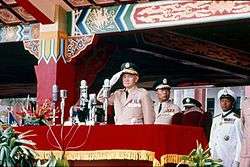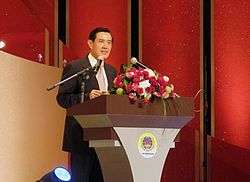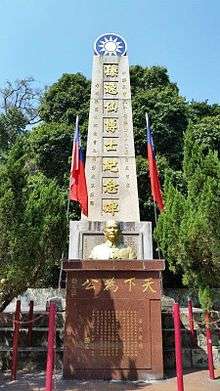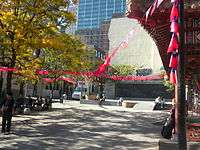National Day of the Republic of China
The National Day of the Republic of China, also referred to as Double Ten Day or Double Tenth Day, is the national day of the Republic of China (ROC). It commemorates the start of the Wuchang Uprising of 10 October 1911 (10-10 or double ten), which led to the end of the Qing Dynasty in China and establishment of the Republic of China on 1 January 1912.
| National Day of the Republic of China | |
|---|---|
 A combination of two 十 ('ten') characters, often seen during the holiday | |
| Also called | Double Tenth Day, Double Ten Day |
| Observed by | |
| Type | Historical, cultural, nationalist |
| Celebrations | festivities, including fireworks and concerts |
| Date | October 10 |
| Next time | 10 October 2020 |
| Frequency | annual |
| National Day of the Republic of China | |||||||||||||
|---|---|---|---|---|---|---|---|---|---|---|---|---|---|
| Traditional Chinese | 國慶日[1] | ||||||||||||
| Simplified Chinese | 国庆日 | ||||||||||||
| |||||||||||||
| Double Ten Day[2] | |||||||||||||
| Traditional Chinese | 雙十節 | ||||||||||||
| Simplified Chinese | 双十节 | ||||||||||||
| |||||||||||||
During the course of the Chinese Civil War, the government of the Republic of China lost control of mainland China, fleeing to the Island of Taiwan in December 1949. The National Day is now mainly celebrated in ROC-controlled Taiwan, but is also celebrated by many overseas Chinese.
Celebration in Taiwan

During the establishment of the ROC, Taiwan was under Japanese rule, which began in 1895. In 1945, after surrender of the Empire of Japan in World War II, Taiwan was placed under the control of the ROC.
In Taiwan, the official celebration begins with the raising of the flag of the Republic of China in front of the Presidential Office Building, along with a public singing of the National Anthem of the Republic of China. It is then followed by celebrations in front of the Presidential Office Building; from time to time, a military parade may occur. Festivities also include many aspects of traditional Chinese and/or Taiwanese culture, such as the lion dance and drum teams, and cultural features coming from Taiwanese aborigines are integrated into the display in recent years. Later in the day, the president of the Republic of China would address the country and fireworks displays are held throughout the major cities of the island. In 2009, all government sponsored festivities for the Double Ten Day were cancelled, and the money intended for the festivals (NT$70 million) were reallocated for reconstruction of the damage done by Typhoon Morakot.
National Day Military Parade





In the past, the Republic of China Armed Forces have traditionally put on a military parade. During this parade, troops and equipment are marched past a reviewing platform in front of the Presidential Office Building. Typically, foreign ambassadors, military officers, and other representatives and dignitaries are invited to view the parade. Following the National Anthem and the firing of a 21-gun salute, the parade commander, a general-ranked officer of any of the service branches of the ROCAF, would then be driven to the front of the grandstand to inform the President of the permission to commence the parade proper. (Until 1975, the President also inspected the parade formations riding a vehicle, as each battalion of the parade formations presented arms in his/her presence and all the unit colours and guidons also dipped in his/her presence.) The presidential holiday address to the ROCAF and the country was the finale of the parade wherein all the units comprising the ground column, following the march past, reassembles at the center of the road for the address.
The parade has been held intermittently during the period of the Republic of China on Taiwan. The military parade on 10 October 1949, was the first public military parade held in Taiwan with Chen Cheng serving as the Grand Review Officer. The 1964 National Day parade was struck by tragedy when a low flying air force F-104 Starfighter fighter aircraft struck a Broadcasting Corporation of China tower, causing the plane's fuel tank to fall and kill three people including a woman and her baby in front of the Central Weather Bureau building in downtown Taipei. The other two remaining F-104 aircraft were ordered to look for the crashed aircraft and accidentally collided and crashed in Tucheng City, Taipei County (now New Taipei City), killing both pilots. The parade was not held again until 1971 (the 60th anniversary), while the mobile column and flypast segments returned in 1975. When Chen Shui-bian became president, the parade was not held until 2007 and then it was entitled a "Celebration Drill" and not a traditional military parade. Since Ma Ying-jeou became president, one parade has been held on the centenary celebrations of the Double Tenth Day, and another on the 105th, the only one under Tsai Ing-wen's presidency.
The tradition of shouting Long Live the Republic of China! ("Zhonghua Mingguo Wansui!" (中華民國萬歲)) at the end of the addresses by the president of the Republic of China was not held for the first time in 2016. It was also the very year that fire and police services joined the parade for the first time in history, breaking a tradition of a purely-military parade to include personnel from civil uniformed services.
List of Republic of China National Day Parades
| Parade Year | Exercise Name | Grand Review Officer | Venue | Parade Commander | Number of Troops | Remarks |
|---|---|---|---|---|---|---|
| 2016 | Tsai Ing-wen | Taipei | 2,500+ | |||
| 2011 | Ma Ying-jeou | Taipei | 1,000+ | The centennial event featured a skydiving show of 12 paratroopers of the Army Airborne Training Center above the plaza in front of the Presidential Office.[3] Military parade involving 1,000+ personnel, 71 aircraft and 168 vehicles.[4] On the part of the ground troops only the ROCAF Honor Guard Battalion and the ROCAF Composite Headquarters Band joined the parade on behalf of the armed forces. | ||
| 2007 | 同慶操演 | Chen Shui-bian | Taipei | Wu Sihuai | 3,000 | Exhibitions presented on national defense, non-traditional military parade |
| 1991 | 華統演習 | Lee Teng-hui | Taipei | Ro Wenshan | 12,566 | ROC Eightieth Anniversary |
| 1988 | 光武演習 | Lee Teng-hui | Taipei | Chen Tingchong | 13,166 | ROC Seventy-Seventh Anniversary |
| 1987 | Chiang Ching-kuo | Taipei | It was the last military parade held during Chiang Ching-kuo's administration. It was held on October 11, the day after the Double Ten Day celebrations due to Chiang's ailing condition. (Also the first since the abolition of Martial Law in Taiwan earlier that July.) | |||
| 1986 | Chiang Ching-kuo | Taipei | ROC Seventy-Fifth Anniversary (Diamond Jubilee) | |||
| 1982 | Chiang Ching-kuo | Taipei | ||||
| 1981 | 漢武演習 | Chiang Ching-kuo | Taipei | Hsu Li-nung | 11,966 | ROC Seventieth Anniversary |
| 1980 | Chiang Ching-kuo | Taipei | ||||
| 1979 | Chiang Ching-kuo | Taipei | Ground column only present, air flypast and military mobile column cancelled Full video of 1979 National Day parade | |||
| 1978 | 漢威演習 | Chiang Ching-kuo | Taipei | Chiang Chung-ling | Flypast cancelled due to rainy weather | |
| 1975 | 大漢演習 | Yen Chia-kan | Taipei | Zhang Jiajun | Full remastered video of 1975 National Day parade | |
| 1971 | Chiang Kai-shek | Taipei | First parade after 6 years absence, marked the 60th Anniversary of the ROC, ground column only present | |||
| 1964 | 興漢演習 | Chiang Kai-shek | Taipei | Hau Pei-tsun | Two F-104 aircraft collided after an air formation, killing both pilots | |
| 1963 | 復漢演習 | Chiang Kai-shek | Taipei | Yuan Guo-Zheng | 15,370 | |
| 1961 | 復興演習 | Chiang Kai-shek | Taipei | Cheng Wei-yuan | ROC Fiftieth Anniversary (Golden Jubilee) | |
| 1960 | 鼎興演習 | Chiang Kai-shek | Taipei | Chu Yuan-Cong | ||
| 1957 | 中興演習 | Chiang Kai-shek | Taipei | Hu Xin | 12,000 | |
| 1956 | 光復演習 | Chiang Kai-shek | Taipei | Liu Dinghan | 21,500 | |
| 1955 | 光華演習 | Chiang Kai-shek | Taipei | Cheng Wei-yuan | ||
| 1954 | n/a | Chiang Kai-shek | Taipei | Xu Rucheng | Artillery battle underway in Quemoy. Flyby aircraft requisitioned for defense of Quemoy. | |
| 1953 | n/a | Chiang Kai-shek | Taipei | Zhou Yuhuan | 19,000 | |
| 1952 | 復華演習 | Chiang Kai-shek | Taipei | Tang Shou-chi | 10,046 | |
| 1951 | n/a | Chiang Kai-shek | Taipei | Ai Ai | ROC Fortieth Anniversary | |
| 1949 | n/a | Chen Cheng | Taipei | Unknown | First military parade held in Taiwan under the control of the Republic of China. | |
Full order of march past for National Day Parades until 1991
Until 1991, following the opening report, and as the joint service honor guard marches off, the massed military bands of the ROCAF, led by the Senior Drum Major, then will have to take their positions as the guard of honor left the grandstand with the bands playing the ROCAF March, a medley of the official songs of the service branches of the armed forces. Then with the bands now in place the parade march past follows in the following manner:
Ground column
- National Armed Forces Joint Color Guard
- Parade commander and staff
- Joint Division of Armed Forces Academies
- Republic of China Military Academy
- Republic of China Naval Academy
- Republic of China Air Force Academy
- National Defense University College of Political Warfare Instruction
- ROC Air Force Institute of Technology
- Chung-cheng Armed Forces Preparatory School
- Army Academy R.O.C.
- Contingent of personnel from the service branches
- ROCA combined divisional formation
- Composite brigade of ROCN personnel (including Republic of China Marine Corps)
- Composite group of ROCAF ground and air defense personnel
- Republic of China Military Police
- Republic of China Joint Logistics Command
- Reserve and militia formations of the Republic of China Armed Forces Reserve
- Female battalion of the College of Political Warfare Instruction
- Drum and Bugle Corps of military educational institutions
- Taiwan Police College (formed part in past parades of the 1970s and 1980s)
- Joint service guard of honor battalion of the General Headquarters, ROCAF
Flypast
The parade's flypast segment was for many years organized in like manner as in the Bastille Day military parade. First, while the honor guard departs from the presidential grandstand the training, fighter and transport aircraft of the ROC Air Force, the transport and anti-submarine aircraft of ROCN Naval Aviation and transport planes of ROCA Army Aviation fly past first, followed by the helicopters of all three service branches, together with those of the National Police Agency, National Fire Agency and Coast Guard Administration after the ground column segment is concluded.
Mobile column
The mobile column, for many years, served as a crowd favorite of National Day civil-military parades, since in this segment the ROC shows off to its people the advanced and modern military equipment and vehicles in service and those being introduced, many of them nationally produced, for use by the servicemen and women of the ROCAF, and since 2016, the state civil security institutions. As in every parade, the ROCMP's motorcycle column leads off the mobile column segment, followed by (as of 2016):
- ROCN mobile column
- Republic of China Marine Corps
- Amphibious Reconnaissance and Patrol Unit
- Amphibious Armor Group
- Coastal and air defense formations of the Republic of China Navy
- Republic of China Marine Corps
- Republic of China Air Force mobile column
- Air defense guns and missiles
- Equipment and materiel, including air to air missiles
- Mobile column of ROCA formations and equipment (order as of 1991, 2007, 2011 and 2016 parades)
- Anti-tank weapons
- Signals
- Armored cavalry
- CBRN defense
- ROCA Corps of Engineers
- Motorized and mechanized infantry
- Armored formations
- Logistical and combat support
- Air defense and missiles (mobile missile and gun systems and truck-towed systems)
- Towed guns of the field artillery
- Self propelled artillery (MRLs and self-propelled guns)
- Disaster risk and response vehicles and equipment for calamity response operations
- National Police Agency
- Criminal Investigation Bureau vehicles and equipment
- NPA National Highway Police
- Mobile vehicles of the NPA's Special Police Corps
- National Fire Agency vehicles and equipment
- Coast Guard Administration small marine equipment and vehicles
Alongside the military and civil security mobile column, in the parades of the 70s and 80s and in more recent parades, a civil mobile column is present, composed of vehicles from the automobile and truck companies, state-owned firms, and the private sector.
Celebration outside Taiwan

Other countries


Overseas Chinese played a key role in the birth of the ROC since the nation's founding father Sun Yat-sen, a medical doctor by training, received financial support mainly from the overseas Chinese communities abroad to overthrow the imperial Qing dynasty and establish the second republic in Asia in 1912. Outside Taiwan, the National Day is also celebrated by many Overseas Chinese communities. Sizable National Day parades occur yearly in the Chinatowns of San Francisco and Chicago.
Mainland China
As the Communist Party of China seized control of mainland China in 1949, October 10 is now celebrated in the People's Republic of China as the anniversary of the Xinhai Revolution and the Wuchang Uprising.
Hong Kong and Macau

The former British colony of Hong Kong celebrated the ROC National Day as a public holiday until the government of the United Kingdom cut its diplomatic relations with the ROC Government as London recognized Beijing in 1950, shortly after the PRC's founding and it was postponed.[5] The former Portuguese colony of Macau had celebrated the ROC national day as a public holiday until the government of Portugal cut its relations as Lisbon recognizes Beijing in 1979. After the civil war in mainland China, the National Day was celebrated in regions inhabited by Chinese patriots who remained loyal to the Republic. Before the sovereignty of Hong Kong was transferred to the PRC in 1997 and Macau also transferred in 1999, many ROC supporters there would display patriotic and colourful flags (mainly the national flag of ROC) to celebrate the National Day. Taiwan agencies in Hong Kong and Macau have annually held a public ceremony to celebrate the National Day of ROC with members of pro-ROC private groups.[6] The day continues to be celebrated in Hong Kong and Macau after the transfer of sovereignty to the mainland, but the national flags publicly shown have been removed by Police of Hong Kong since July 1997 and by Police of Macau since December 1999.[7] Flag-raising ceremony at Hung Lau, Tuen Mun, Sun Yat-sen's revolutionary base, is the most noticeable yearly event, organized by Johnny Mak.
See also
References
- 紀念日及節日實施辦法 (Jìniànrì jí jiérì shíshī bànfǎ)
- 國民中小學九年一貫語文科課程綱要英語科 (Guómín zhōng xiǎoxué jiǔ nián yīguàn yǔwén kē kèchéng gāngyào yīngyǔ kē), p149, 22
- 10 October 2011, Skydiving show wows crowds on National Day, Focus Taiwan news
- Cindy Sui, 10 October 2011, Legacy debate as Republic of China marks 100 years, BBC News
- Far Eastern Economic Review, 1968, page 450
- "Sinorama". Archived from the original on July 20, 2011. Retrieved October 11, 2010.
- 香港移交後之爭議事件
External links

- Republic of China Centenary Foundation (in Chinese)